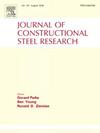Seismic performance of steel-reinforced concrete hybrid structures considering vertical stiffness variations
IF 4
2区 工程技术
Q1 CONSTRUCTION & BUILDING TECHNOLOGY
引用次数: 0
Abstract
The load-carrying capacity and stiffness variation method of transfer connections significantly influence the dynamic response of steel-reinforced concrete vertical hybrid structures. This study proposes a new transfer connection characterized by short steel beams and U-shaped stirrups welded to the bottom of the steel tube to enhance the interaction between the steel tube and the concrete. Additionally, introducing concrete and steel angles inside the steel tube to form a concrete-filled steel tube (CFST) column facilitates smoother stiffness variation along the vertical direction. Five 0.5-scale specimens were designed and fabricated for physical tests. The tests were conducted by applying combined pre-axial loads and lateral cyclic loading to evaluate the seismic performance of the proposed transfer connections. The results demonstrate that incorporating concrete and steel angles inside the steel tube substantially improves the transfer connection's load-carrying capacity, stiffness, and energy dissipation capacity. A larger volume of concrete can enhance stiffness and energy dissipation; however, its effect on load-carrying capacity varies depending on whether steel angles are present inside the tube. Compared with standard EC3, the proposed transfer connection achieves a rigid connection between the structure's steel/CFST and reinforced concrete (RC) parts. Furthermore, a comparison with standards GB 50986, GB 50017, EC4, EC3, and AISC 360 shows that the load-carrying capacity of the proposed connection exceeds that of the steel/CFST column, thereby adhering to the design philosophy of strong connections and weak members.
考虑竖向刚度变化的钢-钢筋-混凝土混合结构抗震性能
传递节点的承载能力和刚度变化方式对钢-钢筋混凝土竖向混合动力结构的动力响应有显著影响。本研究提出了一种新的传递连接方式,其特点是短钢梁和u形马镫焊接在钢管底部,以增强钢管与混凝土之间的相互作用。此外,在钢管内部引入混凝土和钢角,形成钢管混凝土(CFST)柱,使垂直方向的刚度变化更平滑。设计制作了5个0.5比例尺试件进行物理试验。这些试验是通过联合施加预轴载荷和横向循环载荷来评估所建议的传递连接的抗震性能的。结果表明,在钢管内加入混凝土和钢角钢后,传递节点的承载能力、刚度和耗能能力得到了显著提高。混凝土体积越大,刚度越大,耗能越大;然而,其对承载能力的影响取决于钢管内部是否存在钢角。与标准EC3相比,本文提出的转换连接实现了结构钢/CFST与钢筋混凝土(RC)部件之间的刚性连接。通过与GB 50986、GB 50017、EC4、EC3、AISC 360等标准的比较,表明该连接的承载能力超过了钢/CFST柱的承载能力,从而坚持了强连接、弱构件的设计理念。
本文章由计算机程序翻译,如有差异,请以英文原文为准。
求助全文
约1分钟内获得全文
求助全文
来源期刊

Journal of Constructional Steel Research
工程技术-工程:土木
CiteScore
7.90
自引率
19.50%
发文量
550
审稿时长
46 days
期刊介绍:
The Journal of Constructional Steel Research provides an international forum for the presentation and discussion of the latest developments in structural steel research and their applications. It is aimed not only at researchers but also at those likely to be most affected by research results, i.e. designers and fabricators. Original papers of a high standard dealing with all aspects of steel research including theoretical and experimental research on elements, assemblages, connection and material properties are considered for publication.
 求助内容:
求助内容: 应助结果提醒方式:
应助结果提醒方式:


